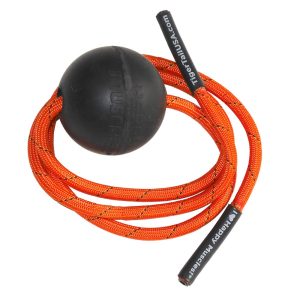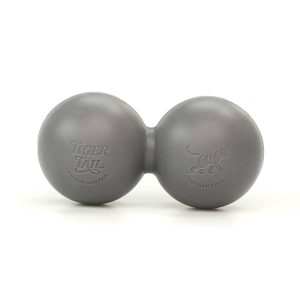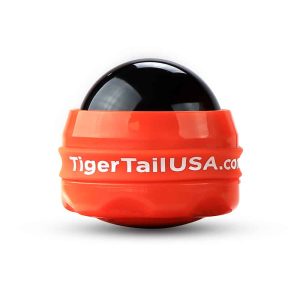Arm Pain
The forearm consists of many muscles that can be categorized as flexors and extensors. Pain in the forearm can originate from muscle knots in muscles located in the neck, shoulder, upper arm, and chest. Pain or discomfort in the forearm can be felt on the sides, top, and bottom of the forearm. Common injuries associated with muscles of the forearm are Tennis Elbow and Carpal Tunnel.
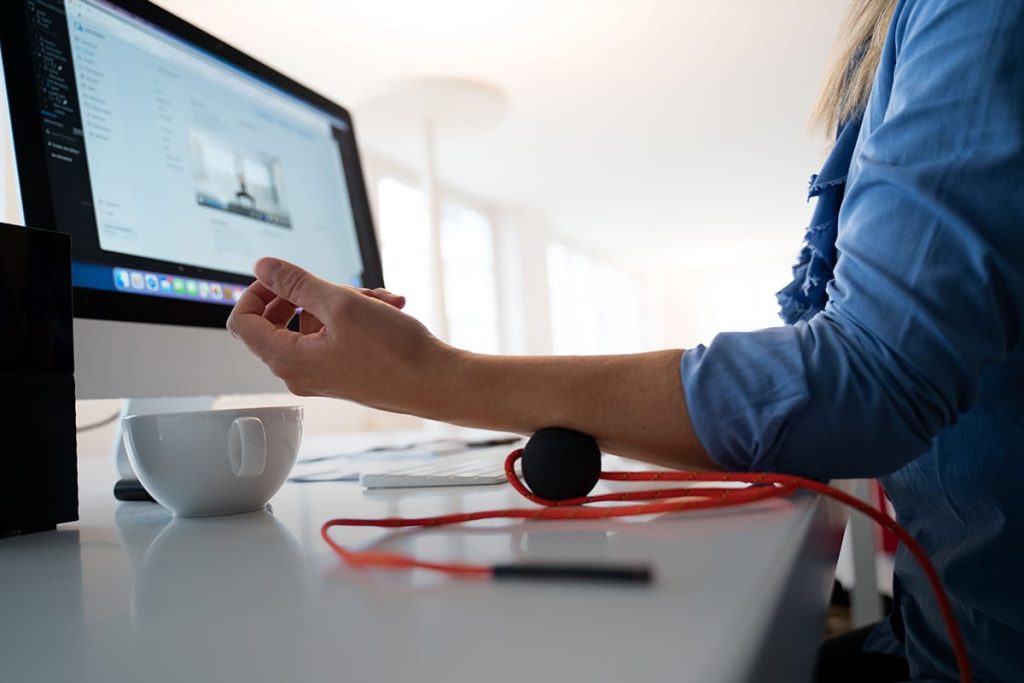
Causes
Gripping an object too tight: Gripping an object too tightly for extended periods can strain the muscles in your forearm and hand, leading to tension that radiates up into the arm. This constant muscle activation can cause small areas of tightness, known as muscle knots, which feel sore and limit mobility. Over time, this can lead to arm pain and fatigue, particularly if gripping becomes a regular habit without regular breaks or stretching.
Holding onto an object for an extended period of time: Holding onto an object for a long time—like a phone, bag, or tool—can cause your arm muscles to stay contracted, which leads to fatigue and strain. This constant tension can create muscle knots, especially in the forearm and upper arm, making the area feel sore or tight. Over time, it can also affect circulation and nerve function, contributing to persistent arm pain.
Overuse: Overusing your arm—whether through repetitive tasks like typing, lifting, or sports—can lead to muscle fatigue and strain. This constant stress can cause tight areas, or muscle knots, to form as your body tries to protect overworked muscles. Over time, these knots can become painful and limit your arm’s flexibility and strength.
Repetitive use: Repetitive use of the arm—like constant typing, lifting, or swinging—can put strain on muscles and tendons, especially if there’s little rest in between. This ongoing stress can lead to tight, overworked muscles that form painful knots, moving feel stiff or sore. Over time, these knots can build up and contribute to chronic arm pain if not addressed with proper care and recovery.
Throwing injuries: Throwing injuries—especially from sports like baseball or javelin—can put a lot of stress on the forearm muscles, leading to strain or minor tears. As the body tries to protect the injured area, nearby muscles may tighten up, forming painful knots that limit movement. Over time, repeated throwing without proper recovery can cause chronic arm pain and muscle tension.
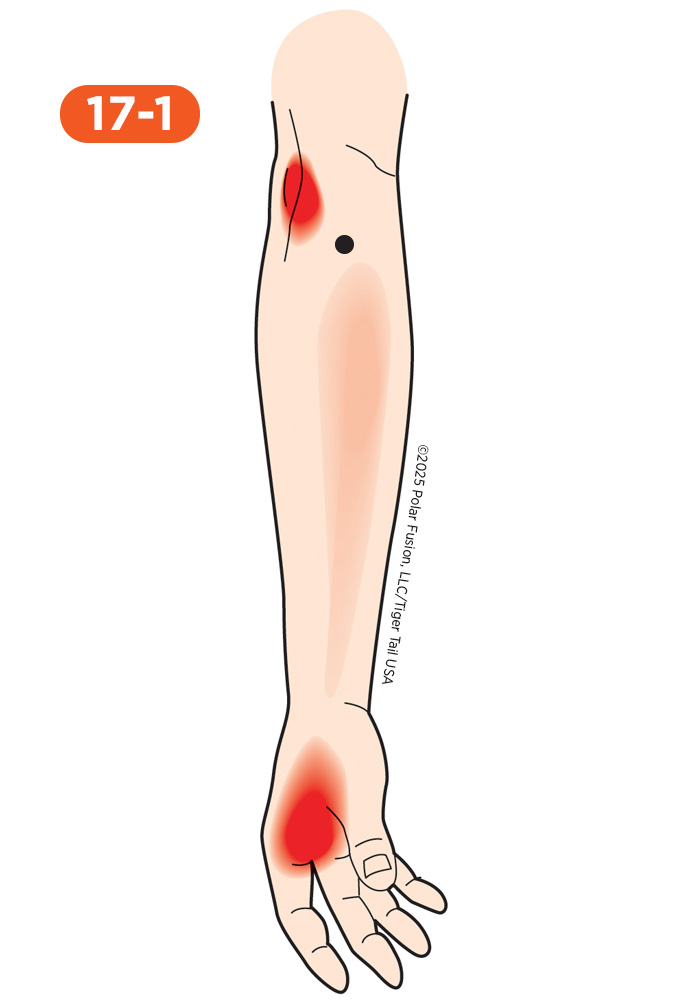
I Feel
Thumb Side Pain
When that prominent muscle in your forearm, the brachioradialis, is causing trouble, the pain you feel is often concentrated right in the middle and outer side of your forearm. It’s usually a deep, stubborn ache that can feel particularly intense near the top of your elbow. This muscle is key for bending your elbow, especially when your thumb is pointing up, so you’ll notice the discomfort gets much worse when you grip things tightly, twist your wrist, or repeatedly lift objects. For instance, carrying a full grocery bag or using a hammer can make the pain flare up. The stiffness here can sometimes be mistaken for elbow tendon issues, but it’s really the muscle complaining from overuse, leaving your entire grip feeling weak and painfully tight.
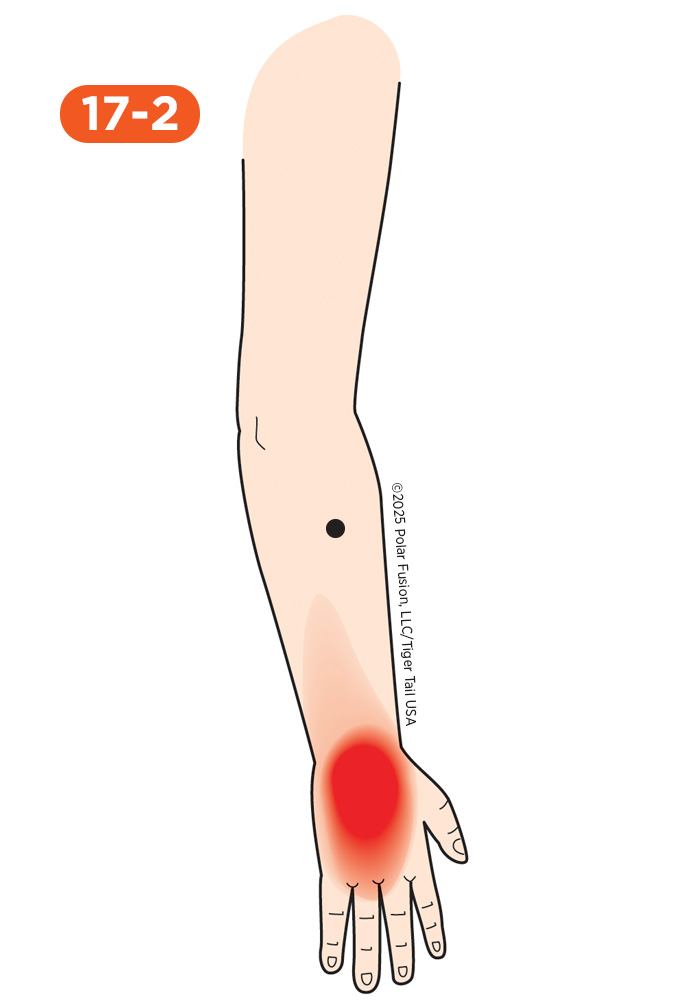
I Feel
Tennis Elbow
When the muscles that pull your wrist back, specifically the extensor carpi radialis brevis and longus, get overworked, you end up with the frustrating condition known as tennis elbow. You’ll feel a sharp, intense pain right on the outside bump of your elbow, and that discomfort often radiates down the back of your forearm toward your wrist. It can be super painful just to grip something tightly, like a handshake, a coffee cup, or a wrench. This happens because the tendons where these muscles attach to the elbow bone get inflamed from repetitive use—like excessive hammering, turning a screwdriver, or typing without proper wrist support. When these muscles are irritated, they make twisting and gripping movements surprisingly weak and instantly painful.
Outer Forearm Pain
That deep, persistent forearm pain on the top side of your arm is often caused by chronic muscle knots in the shorter, deeper forearm muscle, the extensor carpi radialis brevis. The discomfort usually focuses along the outer forearm, running from the elbow toward the wrist, and appears as a deep, constant ache that makes gripping difficult. You’ll find the pain worsens when engaging in activities that grip or twist the wrist, such as shaking hands firmly, turning a heavy doorknob, or lifting a full coffee cup with the palm down. Because the extensor carpi radialis brevis stabilizes the wrist and is a key contributor to tennis elbow, its knotting can easily mimic deeper issues like lateral epicondylitis or radial nerve irritation. The tissue high on the back of the forearm is sensitive to pressure, leaving your wrist feeling weak and restricted, and limiting your hand strength.
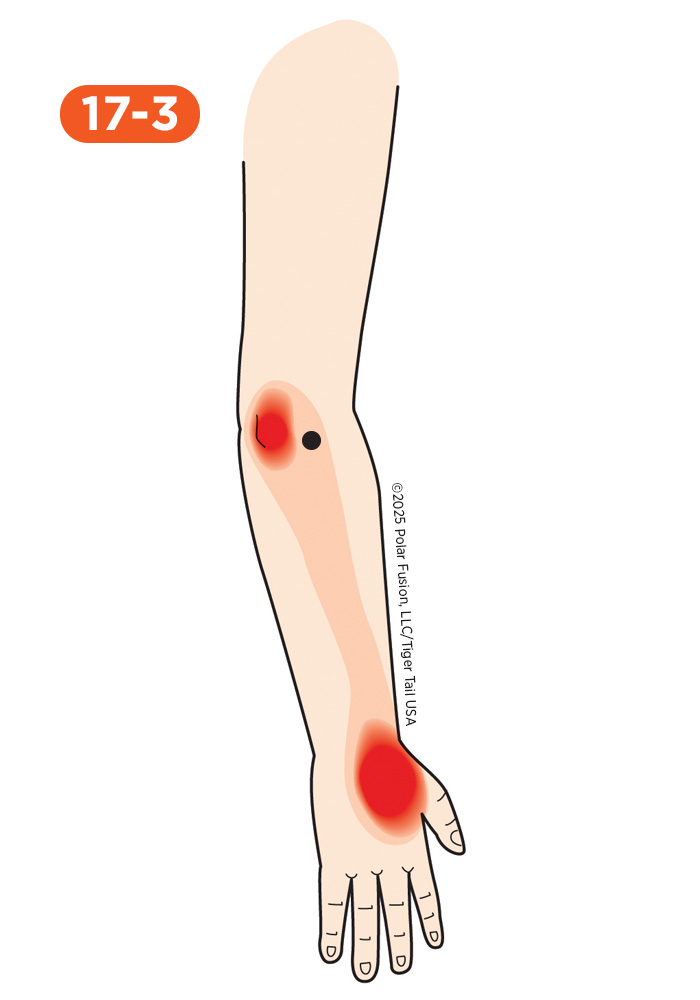
I Feel
Top of Forearm Pain
Tennis Elbow
When the muscles that pull your wrist back, specifically the extensor carpi radialis brevis and longus, get overworked, you end up with the frustrating condition known as tennis elbow. You’ll feel a sharp, intense pain right on the outside bump of your elbow, and that discomfort often radiates down the back of your forearm toward your wrist. It can be super painful just to grip something tightly, like a handshake, a coffee cup, or a wrench. This happens because the tendons where these muscles attach to the elbow bone get inflamed from repetitive use—like excessive hammering, turning a screwdriver, or typing without proper wrist support. When these muscles are irritated, they make twisting and gripping movements surprisingly weak and instantly painful.

I Feel
Forearm to Middle Finger Pain
That persistent pain in your forearm, especially when extending your fingers, is often due to tight muscle knots in the specific muscle responsible for moving your middle finger, the middle finger extensor. The discomfort typically concentrates along the back of the forearm (mid-line) and can radiate along the top of the hand toward the knuckle. You may notice the pain worsens with repetitive finger movements like typing quickly, playing a musical instrument, or flicking your wrist. Because this muscle is so specific, its knotting can easily mimic deeper issues such as tendinitis or nerve irritation in the elbow. The tissue along the center-top of the forearm is sensitive to pressure, and this can make your middle finger feel restricted, limiting its dexterity.
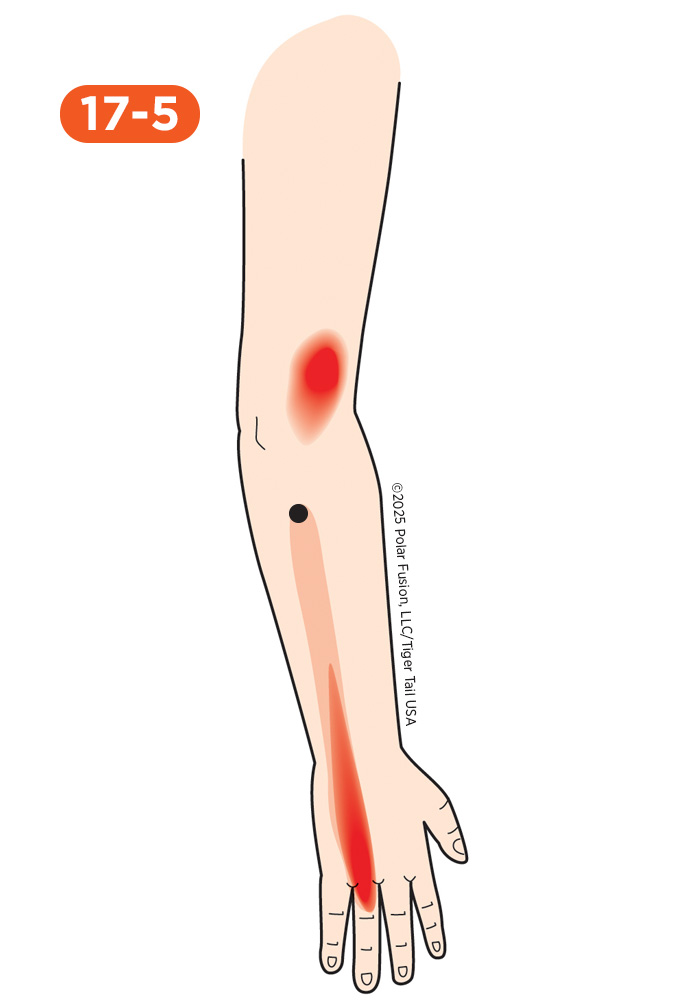
I Feel
Forearm to Ring Finger Pain
The persistent pain that runs from your forearm to your ring finger, making gripping and typing uncomfortable, is often caused by muscle knots in the muscle that controls your ring finger—the ring finger extensor. This pain from the muscle knots is commonly felt as a deep, burning ache along the outer part of your forearm, extending down to the back of your ring finger. It may also cause a sensation of weakness or stiffness in that finger, which can be mistaken for tendonitis, nerve compression (like radial tunnel syndrome), or arthritis in the finger joint. You might notice the pain worsening when you type or use a keyboard for extended periods, grip objects tightly (such as a steering wheel or tools), perform repetitive finger extension movements, play musical instruments that require finger dexterity, or hold your hand in sustained positions that keep your fingers extended. When you press into the muscle on the back of your forearm, it will likely be tender with tight bands, and your ring finger may feel restricted and weak.

I Feel
Outer Forearm Pain
That deep, aching forearm pain that worsens when you turn your hand is often caused by chronic muscle knots in the deep muscle that rotates your forearm, the supinator. The discomfort usually concentrates deep beneath the forearm muscles near the elbow, appearing as a deep, constant throbbing that feels like a strain. You may notice the pain intensifies during activities that twist the forearm, such as turning a screwdriver, wringing out a cloth, or reaching to turn a key in a lock. Because the supinator wraps around the bone and is near the radial nerve, its knots can easily mimic more serious issues like radial tunnel syndrome or lateral epicondylitis. The muscle tissue deep on the outer forearm is highly sensitive to pressure, and the tightness can impair your ability to rotate your palm upward.

I Feel
Golfer's Elbow
That sharp, pinpoint pain right on the bony bump inside your elbow that feels exactly like golfer’s elbow is often caused by chronic muscle knots in one of the main wrist flexor muscles running down the palm side of your forearm, the flexor carpi radialis. The pain from these muscle knots is often experienced as a sharp, burning ache right at the inner elbow that can radiate down the forearm toward the palm side of your wrist, sometimes causing weakness when you try to grip or flex your wrist. This can be mistaken for medial epicondylitis (true golfer’s elbow), tendon tears, or ulnar nerve irritation. You’ll notice the pain worsening when swinging a golf club, lifting heavy objects with your palm facing up, hammering nails, doing pulling exercises like rows, typing with your wrists in flexion, or performing any repetitive gripping and wrist flexion activities. When you press into the muscle high on your inner forearm (just below where it attaches at the elbow), you’ll likely find it especially tender with tight, ropy bands, and your wrist may feel weak and restricted—like you’ve lost your comfortable grip and that sharp elbow pain makes you want to avoid using your hand.

I Feel
Golfer's Elbow
That sharp pain on the inside of your elbow that everyone thinks is golfer’s elbow can also come from chronic muscle knots in the inner forearm muscle that runs from your inner elbow down to the little finger side of your wrist, the flexor carpi ulnaris. The pain from these knots often feels like a sharp, localized ache right on the bony bump inside your elbow and can radiate down the inner edge of your forearm to your pinky side, sometimes with tingling or numbness in your ring and little fingers. This can be mistaken for medial epicondylitis, ulnar nerve entrapment (cubital tunnel syndrome), or tendon inflammation. You’ll notice the pain worsens when you squeeze tools tightly, pull forcefully with a bent elbow, carry heavy suitcases or bags, do chin-ups or pull-ups, or lean on your elbow for long periods. Pressing on the flexor carpi ulnaris will likely make it feel very sore and reactive, and your wrist may feel guarded and restricted.

I Feel
The Mid-Forearm Pain That Mimics Carpal Tunnel
If you’ve got a nagging, deep ache in the middle of your forearm—especially on the palm side—and it feels like tingling or numbness in your hand might be caused by muscle knots in the muscle which helps rotate your forearm inward, the pronator teres. When this muscle becomes tight or develops knots, it can press on the median nerve, causing symptoms that resemble those of carpal tunnel syndrome or tendonitis. You’ll find that the pain gets worse when you’re doing activities that twist the forearm inward, such as turning a doorknob forcefully, using a keyboard for long periods, or driving with your palms down. The inner part of your upper forearm can feel tender to the touch, and you may feel like your arm is stiff or guarded, making everyday movements more difficult.
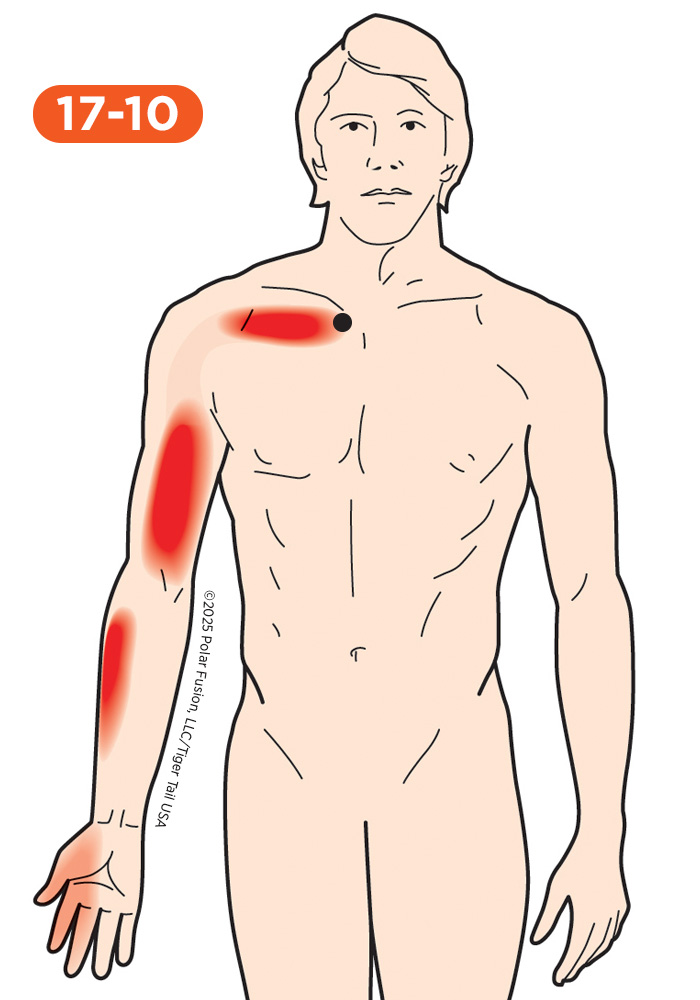
I Feel
Forearm Pain
Sometimes, forearm pain doesn’t originate from the forearm itself—it can actually be referred from a small muscle beneath your collarbone called the subclavius. When this muscle tightens or develops knots, it can send a dull, aching pain down the inside of your arm and into your hand, sometimes even causing tingling or numbness. You might notice the pain worsens when you carry a heavy bag, push open a door, or sleep on your stomach with your arm stretched out. The subclavius helps stabilize your collarbone, and when it’s irritated, it can mimic nerve issues like thoracic outlet syndrome. The area under your collarbone can be vulnerable to pressure, and when this muscle is involved, your arm may feel heavy, restricted, or more difficult to move. Even though the pain appears in your forearm, the actual problem might be hiding up near your shoulder. Because of its location near major nerves and vessels, issues with the Subclavius can contribute to a feeling of heaviness or vague numbness down the arm, making your shoulder feel weak and unreliable.

I Feel
Inside Forearm Pain
Suppose you feel a deep ache or strange discomfort along the inside of your forearm. The real problem might originate higher up—specifically from muscle knots in the serratus anterior, a muscle wrapping around your ribcage that helps move and stabilize your shoulder blade. When it develops tight knots, it can send pain down the arm, especially along the inner side, and even into the hand and fingers. You might notice that the pain worsens significantly when you do activities like taking a deep, forced breath, pushing a heavy object, or making repetitive arm swings (like during running). Since this muscle supports shoulder movement and breathing, tension here can make your arm feel restricted or heavy, even though the pain appears farther down, often mimicking a deep nerve pinch or a stitch in your side.
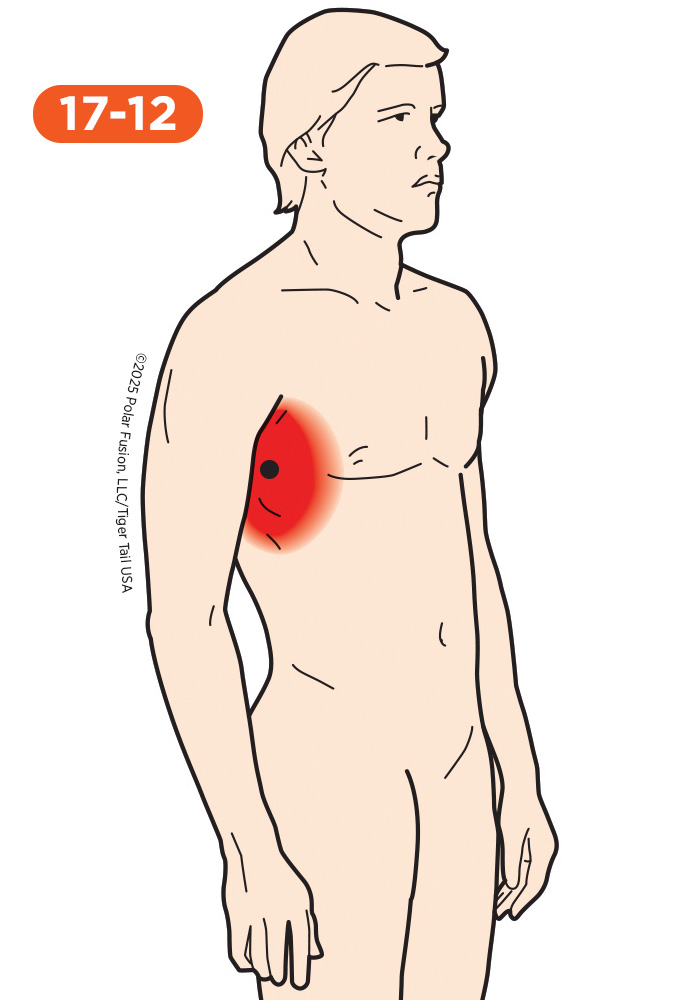
I Feel
Side of Chest Pain
If you’re feeling a deep ache or strange discomfort along the side of your chest, the true cause might be a muscle deep beneath your arm and ribs called the serratus anterior. This muscle wraps around your ribcage and helps move and stabilize your shoulder blade. When it develops muscle knots, it can cause pain along the ribs, sometimes feeling like a sharp, shooting ache that travels along the side of your chest, back, shoulder, and sometimes down your arm. You may notice that the pain worsens significantly during activities such as taking a deep, forced breath, pushing a heavy object, or performing repetitive arm swings (like during running). Since this muscle supports both shoulder movement and breathing, tension in it can easily mimic deeper problems like a rib joint issue or a side stitch. The tissue under the armpit is often vulnerable to pressure, which can leave your chest feeling restricted and limit the depth of your breath.

I Feel
Back of Arm Pain
That mysterious, achy pain down the back of your arm is often referred pain originating from tight muscle knots in a thin muscle situated deep under your upper shoulder blade, the serratus posterior superior. The discomfort usually focuses deep within the triceps area and can radiate along the back of your shoulder and up into your neck. You’ll notice the pain becomes significantly worse during activities that stress the rib cage, like taking a deep, forced breath, coughing, sneezing, or reaching forward to lift a heavy object. Since this muscle assists in elevating the ribs for breathing, its knotting can easily mimic more serious issues, such as ulnar nerve irritation or a cervical nerve pinch. When you press into this muscle (located deep beneath your shoulder blade, near the upper inner corner where it meets your spine), it’s likely to be very tender, though difficult to access, and your arm may feel achy and fatigued – like a constant deep discomfort running down the back that hampers comfortable arm movement or relief.
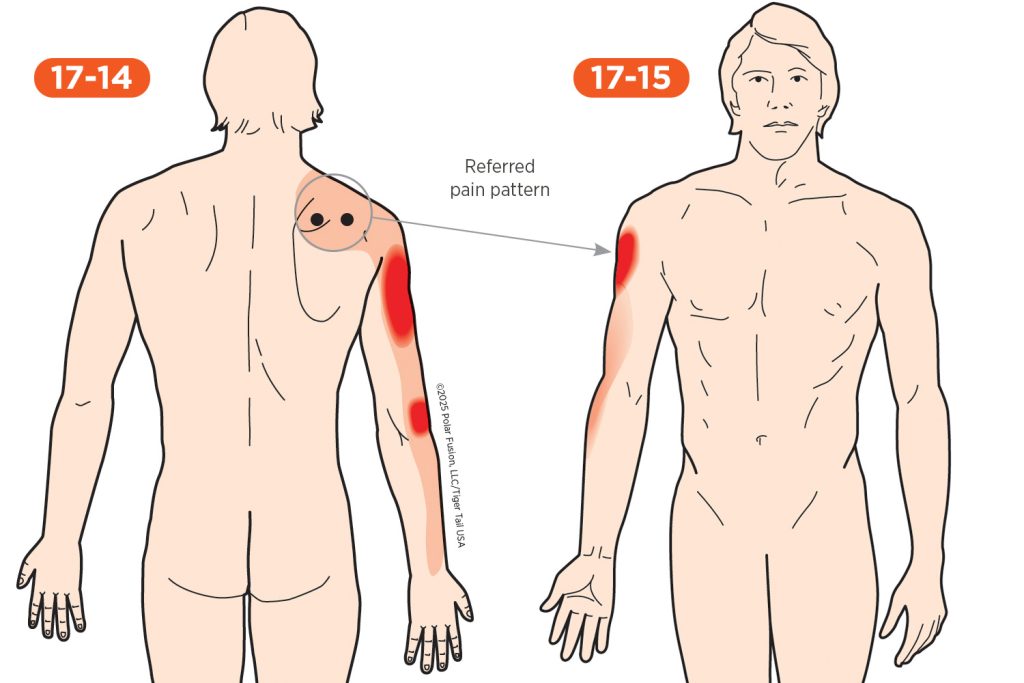
I Feel
Outside Arm Pain
That persistent, aching pain on the outside of your arm is a classic referred pain pattern from tight muscle knots in the rotator cuff muscle, the Supraspinatus. The discomfort typically focuses right on the shoulder’s side and halfway down the upper arm, presenting as a deep, dull ache that can worsen at night. You’ll notice the pain becomes significantly worse during activities that require lifting the arm, such as reaching for an overhead cabinet, lifting a heavy suitcase, or shrugging your shoulders repeatedly. Because the Supraspinatus helps initiate arm movement and stabilize the joint, its knotting can easily mimic deeper issues like a rotator cuff tear or bursitis. When you press into the supraspinatus, it can leave your shoulder feeling guarded and restricted, making overhead movements difficult.

I Feel
Forearm Pain
If you’re experiencing unexplained pain, tingling, or numbness in your forearm or hand, the cause might actually be a muscle at the back of your shoulder blade, known as the infraspinatus. When this muscle develops knots, it can refer pain down your arm and into your fingers, often mimicking nerve issues. You may notice symptoms like weakness or tingling in your hand, especially during shoulder movements or when your arm is at rest. These muscle knots can confuse the nervous system, making it seem like the pain is coming from your arm when it actually starts in your shoulder. Activities such as throwing, lifting, or poor posture at a desk can worsen this condition. The infraspinatus may be tender to touch and can cause your forearm to feel restricted and heavy, diminishing your hand strength.
Upper Arm Pain
Many of the muscles that attach to the neck and shoulder will refer pain to the upper arm. Muscle knots in the scalene muscles of the neck can cause pain in the right upper arm. There are two main muslces of the upper arm. The Biceps Brachii muscles is on the front of the upper arm and allows the elbow to bend. The Triceps Brachii muscle is on the back of the arm and allows the elbow to straighten. Muscle knots in the belly of these muscles can cause pain in the upper arm.
Causes
Hard serving in tennis: Hard serving in tennis puts a lot of force and speed through the shoulder and upper arm, which can strain muscles and tendons if not properly warmed up or conditioned. This repeated high-impact motion can lead to tightness and muscle knots, especially in the deltoid and triceps areas. Over time, these knots can cause upper arm pain and limit your ability to serve with power and control.
Lifting heavy objects with the palm of the hand in an upward position: Lifting heavy objects with your palm facing upward puts extra strain on the biceps and upper arm muscles, especially if the load is awkward or held for a long time. This position can cause those muscles to overwork, leading to tightness and the development of painful muscle knots. Over time, repeated lifting like this without proper support or technique can result in upper arm pain and reduced mobility.
Overuse of crutches: Overusing crutches can place a lot of repetitive pressure on the upper arms, especially the triceps and shoulder muscles, as they work hard to support your body weight. This constant strain can lead to muscle fatigue and the development of painful knots in overworked areas as muscles try to stabilize and protect themselves. Over time, this can result in upper arm pain and reduced mobility if not balanced with rest and proper technique.
Using a can that is too long: Using a cane that’s too long can force your arm and shoulder into an unnatural position, causing extra strain with every step. This awkward posture can lead to muscle fatigue and the development of painful knots in the upper arm and shoulder area. Over time, it can contribute to persistent discomfort and limit your arm’s range of motion.
Overuse: Overuse of the upper arm—like repeated lifting, pushing, or reaching—can strain muscles and tendons, especially if done without enough rest or proper form. This ongoing stress can lead to tight, overworked muscles that form painful knots and limit mobility. Over time, these knots can cause persistent upper arm pain and make everyday movements feel uncomfortable.


I Feel
Discomfort in the Back of the Upper Arm
That deep, constant discomfort in the back of your upper arm is often caused by tight muscle knots in the large muscle at the back of the upper arm, the triceps brachii. The discomfort usually focuses along the muscle belly, running between the shoulder and the elbow, and presents as a deep, persistent ache that makes your arm feel heavy and fatigued. You’ll find that the pain worsens significantly during activities that involve elbow extension or heavy pressing, such as pushing a heavy door, doing overhead presses, or carrying a heavy object like a box. Because the triceps constantly work to support your arm, its knotting can easily mimic more serious problems like tendinitis or ulnar nerve irritation. The muscle belly on the back of the upper arm is highly sensitive to pressure, which can leave your arm feeling guarded and restricted, making it difficult to fully relax.
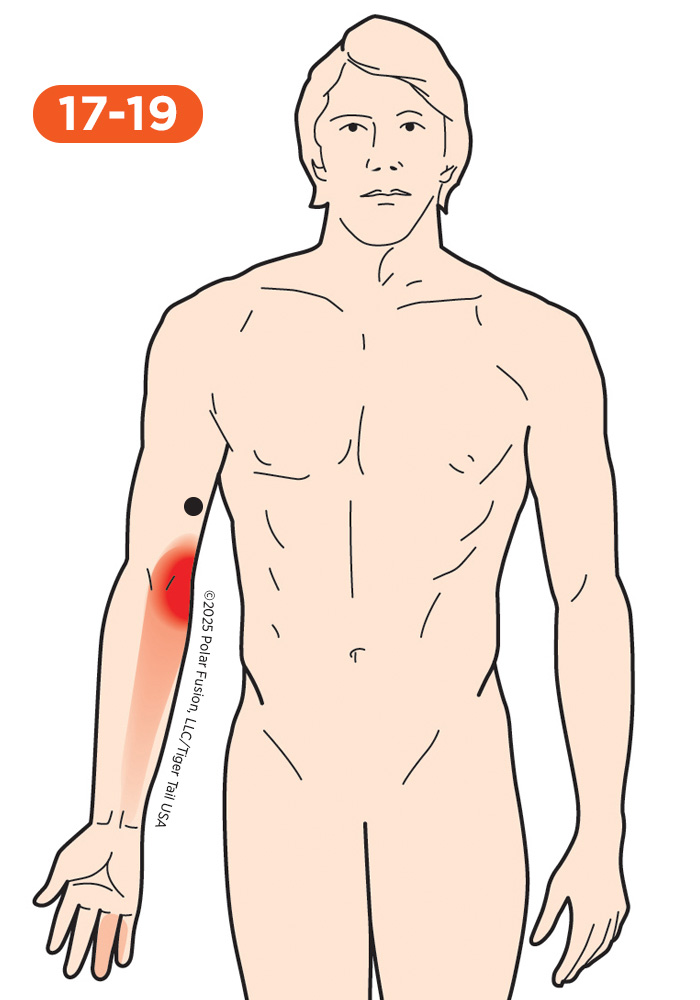
I Feel
Forearm Pain
If you’re experiencing pain or tension in your forearm, especially when straightening your arm or pushing against something, the cause might actually be coming from the large muscle on the back of your upper arm, the triceps brachii. When this muscle develops tight knots or trigger points, it can refer pain down into the elbow and forearm, even reaching the hand. You might notice discomfort during activities like push-ups, lifting, or even typing for long periods with your arms held in one position. These muscle knots can make it difficult to fully extend your arm, and you may unconsciously keep your elbow slightly bent to avoid the pain. The triceps is responsible for straightening the elbow and assisting with shoulder movement, so tension here can affect both arm strength and mobility.

I Feel
Carpal Tunnel Syndrome
That tingling, numb feeling in your hand and fingers that mimics carpal tunnel syndrome is often caused by tight muscle knots in the deep neck muscles, the scalenes (scaleni). The discomfort usually concentrates along the inner arm and radiates into the thumb and first two fingers, presenting as a sharp, burning tingle. You might find the tingling and pain worsen when you’re doing activities that stress the neck and ribs, like carrying a heavy bag on one shoulder, sleeping with your arm pulled up, or slouching over a computer. Because the scalenes compress the nerve and blood vessels, their knotting can easily resemble deeper problems like true carpal tunnel syndrome or cervical disc irritation. The tissue on the side of the neck is extremely sensitive to pressure, causing your hand to feel heavy and restricted, which limits grip strength.
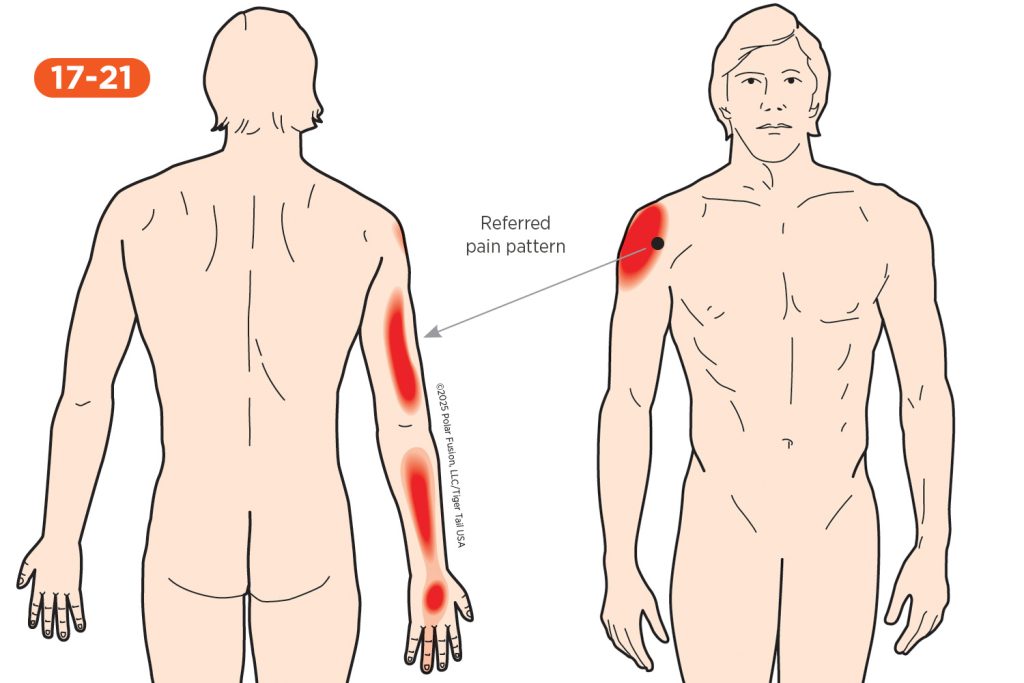
I Feel
Back of Arm Pain
That deep, achy pain down the back of your upper arm is often referred pain caused by tight muscle knots in the small muscle near your armpit, the coracobrachialis. The discomfort usually concentrates along the back of the upper arm and triceps area, presenting as a deep, dull ache that makes your arm feel heavy and tired. You’ll notice the pain worsens when you’re doing activities that shorten the muscle, like holding your arm across your chest, lifting objects with your elbow bent, or sitting with your arms forward. Because the coracobrachialis is central to upper arm movement, its knotting can easily mimic deeper issues like triceps tendinitis or ulnar nerve irritation. The tissue deep in the armpit area is very sensitive to pressure, and it can leave your arm feeling guarded and restricted, making it hard to fully straighten your elbow.
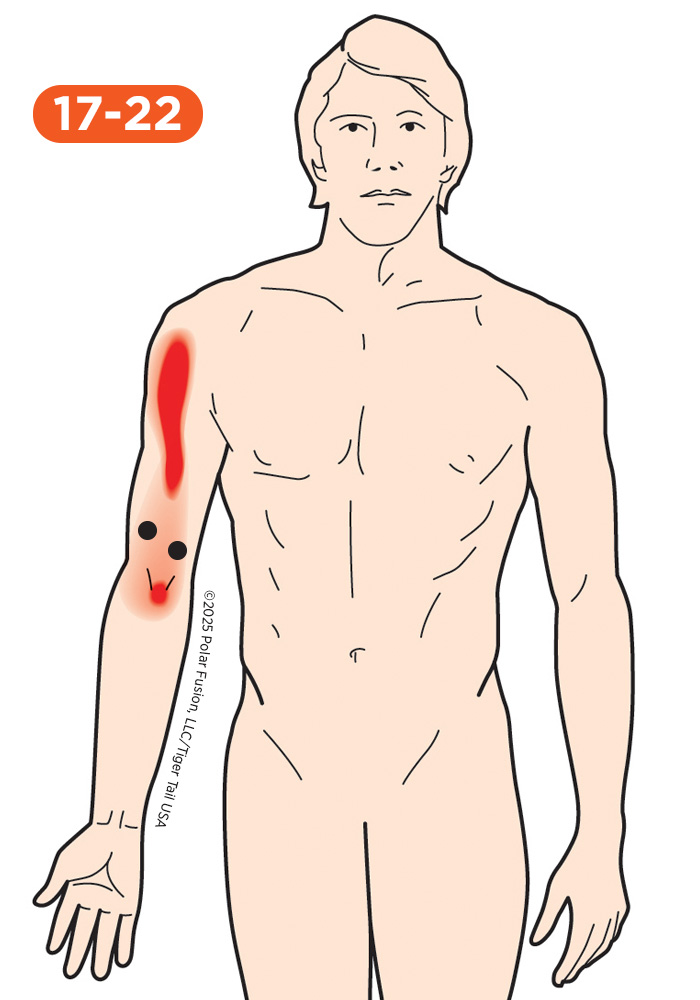
I Feel
Pain or Discomfort Lifting the Arm to the From or to the Side
That sharp pain or discomfort when lifting your arm forward or to the side is often caused by tight muscle knots in the main muscle at the front of your arm, the biceps brachii. The discomfort usually focuses at the front of the shoulder and down the front of the arm, felt as a deep, pinching ache during movement. The pain often worsens with activities that stretch or stress the shoulder tendon, such as reaching for an overhead cabinet, throwing a ball, or carrying a heavy bag away from your body. Since the biceps help lift and stabilize the shoulder, its knotting can mimic more serious issues like biceps tendinitis or shoulder impingement syndrome. The biceps brachii can be sensitive to pressure, which may leave your shoulder feeling guarded and restricted, limiting your comfortable overhead reach.
Pain or Discomfort Bending the Elbow
That sharp, aching pain you feel whenever you bend your elbow is often caused by muscle knots in the upper arm muscle, the biceps brachii. The pain from these knots is usually experienced as a deep, burning ache in the front of your shoulder and upper arm, which worsens when you bend your elbow. This can sometimes be mistaken for biceps tendinitis, anterior shoulder impingement, or elbow tendon strain. You’ll really notice the pain getting worse when lifting objects toward your body, doing bicep curls or pulling exercises, carrying bags with your elbow bent, typing, or working with your elbows flexed for a long time, or any repetitive elbow bending activity. When you press into the muscle on the front of your upper arm—the belly of the biceps between your shoulder and elbow—you’ll likely find it very tender, with tight, knotted bands running through it. Your elbow may also feel weak and painful, like you can’t comfortably bend your arm or lift objects without that sharp, burning discomfort that makes you want to keep your arm straight.
Discomfort when Holding Something Like a Bag of Groceries for Prolonged Periods of Time
That dull discomfort when holding something like a grocery bag for a long time is often caused by tight muscle knots in the main muscle on the front of your arm, the biceps brachii. The discomfort usually concentrates along the muscle belly and near the shoulder joint, presenting as a deep, dull ache that makes your arm feel constantly tired. You’ll notice the pain worsens when you’re doing activities that require your muscles to stay still and strong for a while, such as carrying a heavy suitcase, holding a child on your hip, or working with your elbows bent for an extended period. Because the biceps brachii constantly fights against gravity during these tasks, its knotting can easily mimic deeper issues, such as shoulder tendinitis or forearm nerve fatigue. The muscle belly in the middle of the arm can be sensitive to pressure, leaving your arm feeling weak and restricted, which limits your ability to hold objects for sustained periods.
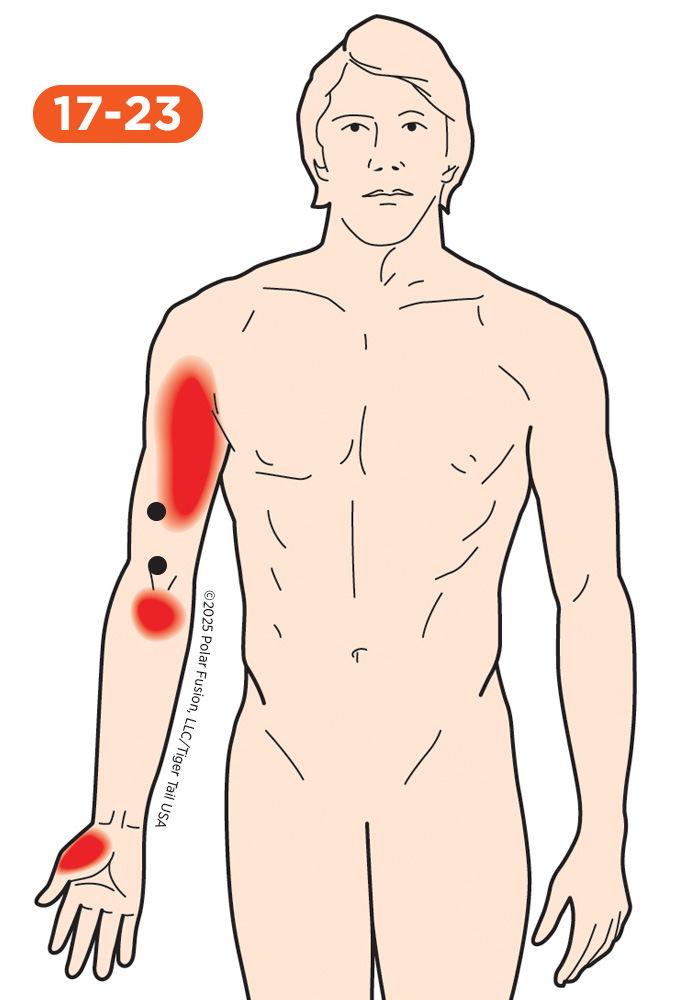
I Feel
Pain or Discomfort Lifting the Arm to the From or to the Side
If you feel pain when lifting your arm forward or to the side, it might not be your shoulder—it could come from a deep muscle in your upper arm called the brachialis. This muscle sits beneath the biceps brachii and plays a key role in elbow movement, especially when your palm faces down. When it’s overused or strained, it can develop muscle knots that cause pain in the shoulder and forearm. You might notice aching or weakness when lifting objects, carrying bags, or reaching for something. Because it’s hidden under the biceps, brachialis pain is often mistaken for issues with the biceps or shoulder, nerve irritation, or carpal tunnel syndrome. It can make your entire arm feel heavy, weak, and surprisingly limited in daily activities.
Pain or Discomfort Bending the Elbow
Discomfort when Holding Something Like a Bag of Groceries for Prolonged Periods of Time
Carpal Tunnel Syndrome
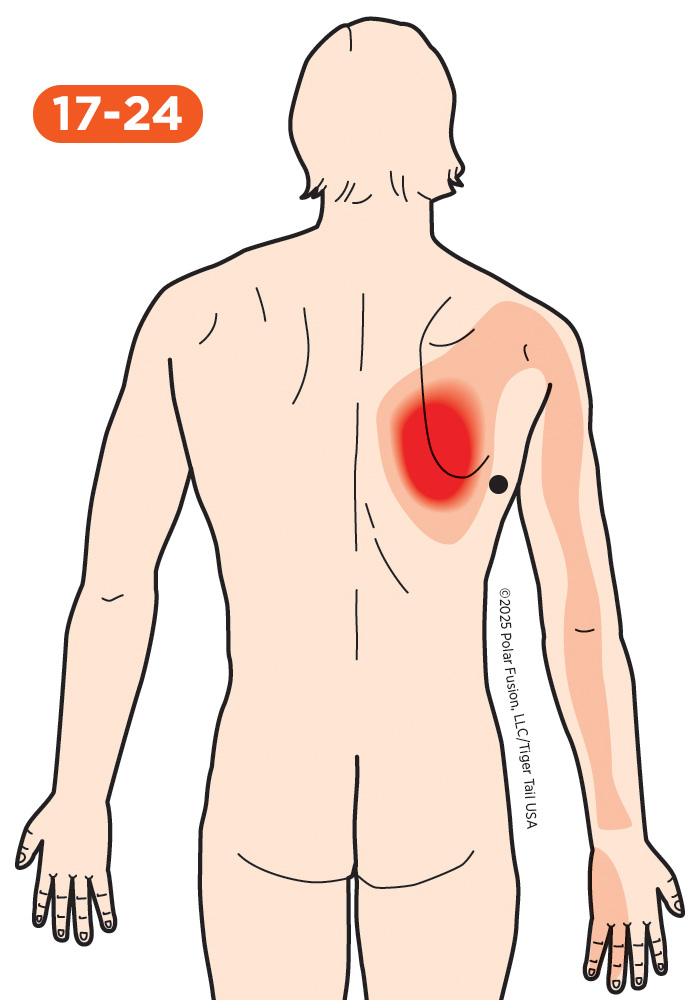
I Feel
Back of Arm Pain
That deep, nagging pain running down the back of your arm that’s hard to shake is often caused by muscle knots in the large, wing-like muscle that stretches from your mid-back to your lower back, the latissimus dorsi. The pain from these muscle knots is usually felt as a deep, aching pain in the back of your shoulder and upper arm, which can radiate down toward your elbow and even into your ring and pinky fingers, sometimes creating a band-like sensation of discomfort. This can be mistaken for rotator cuff problems, thoracic outlet syndrome, or ulnar nerve compression. You’ll notice the pain worsening when doing pulling exercises like pull-ups or rows, reaching overhead, swimming (especially freestyle or butterfly), carrying heavy bags, sleeping on the affected side, or any activity that involves pulling your arm down and back. When you touch the muscle, you’ll likely find it very tender with tight, ropy bands, and your arm may feel restricted and achy.

I Feel
Front of Arm Pain
That mysterious, achy pain in the front of your arm often comes from tight muscle knots in the large “wing” muscle on your back, the latissimus dorsi. The discomfort usually concentrates along the inside of the upper arm and near the armpit, presenting as a deep, dull ache that can feel like constant fatigue. The pain tends to worsen with activities involving reaching or pulling, such as pulling open a heavy door, carrying a heavy suitcase, or reaching overhead for an extended period. Because the latissimus dorsi connects the arm to the spine and ribs, its knotting can easily imitate deeper issues like biceps tendinitis or brachial plexus irritation. The tissue on the side of your back near the lower ribs is sensitive to pressure, causing your arm to feel heavy and restricted, which can limit your ability to lift or stretch.

I Feel
Upper Arm Pain
That persistent upper arm pain that seems resistant to stretching often originates from tight muscle knots in the largest and deepest rotator cuff muscle, the subscapularis. The discomfort usually concentrates along the outer upper arm and armpit area and can radiate deep into the shoulder joint, presenting as a deep, aching throb that often worsens at night. You may notice the pain becomes significantly more intense when performing activities that compress the shoulder, such as sleeping on the affected side, throwing a ball, or carrying a heavy bag across your chest. Since the subscapularis helps stabilize the shoulder, chronic knotting in this muscle can mimic more serious issues like shoulder joint arthritis or bursitis. The muscle tissue deep in the front of the shoulder is highly sensitive to pressure, which can leave your entire arm feeling guarded and restricted, making sustained use difficult.
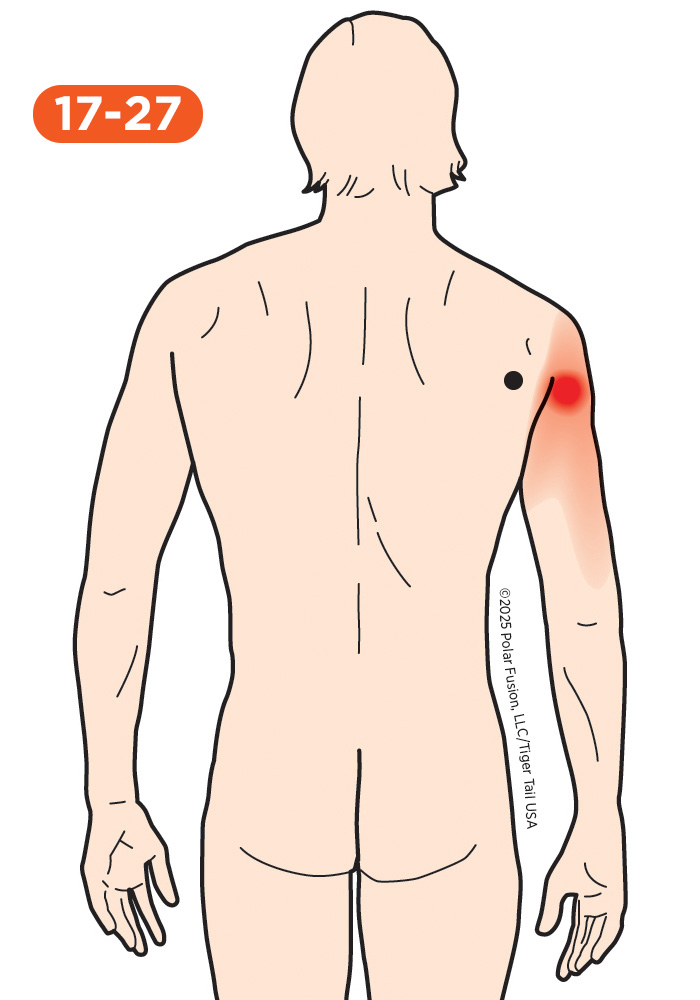
I Feel
Upper Arm Pain
That persistent, aching pain in your upper arm often results from tight muscle knots in the small stabilizing muscle, the teres minor. The discomfort usually concentrates on the side of the upper arm and the back of the shoulder joint, presenting as a deep, dull ache that can worsen at night. You might notice the pain intensifies during activities that involve rotation or reaching, such as tucking in your shirt, reaching across your body, or sleeping on the affected side. Since the teres minor externally rotates the arm, its knotting can easily imitate more serious issues like a rotator cuff tear or bursitis. The muscle tissue deep within the back of the shoulder is highly sensitive to pressure, often leaving your shoulder feeling guarded and restricted, which limits comfortable rotation.
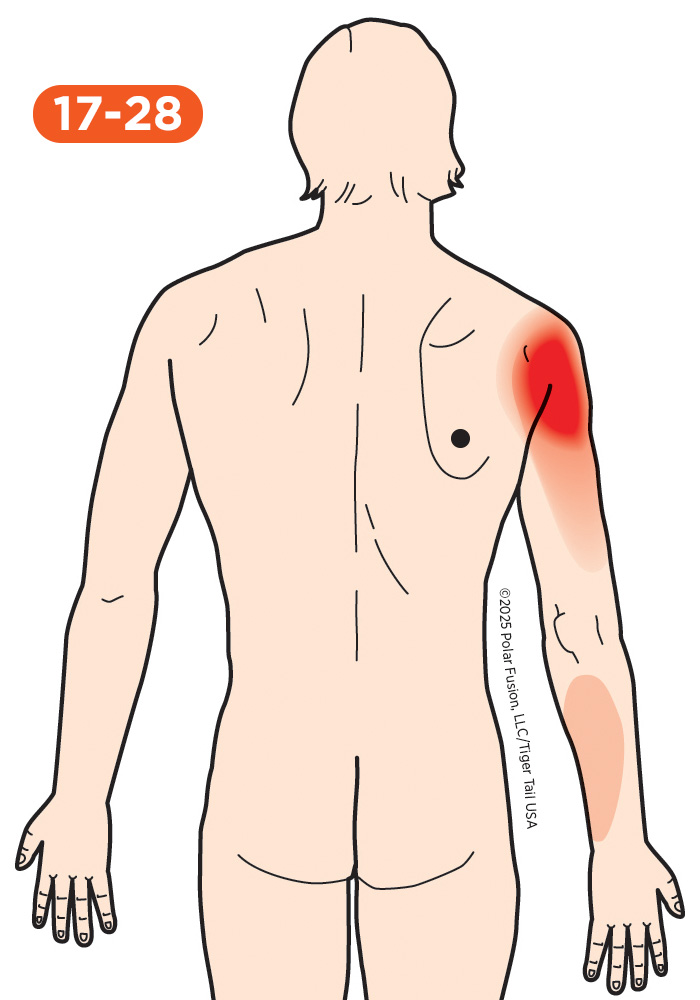
I Feel
Back of Arm Pain
That persistent, aching pain in your upper arm often comes from tight muscle knots in the small stabilizing muscle, the teres minor. You’ll usually experience a strong, ongoing ache along the back of your upper arm that may spread toward the armpit. This muscle’s main job is to help pull your arm down, backward, and toward your body (imagine swinging a tennis racket or doing a powerful row). As a result, you might notice the pain worsens during activities that involve forceful pulling or lifting. It can be very tender if you press just below your armpit, and when this muscle is tight, it can significantly limit your ability to reach overhead, making your entire arm feel heavy and resistant to full movement.
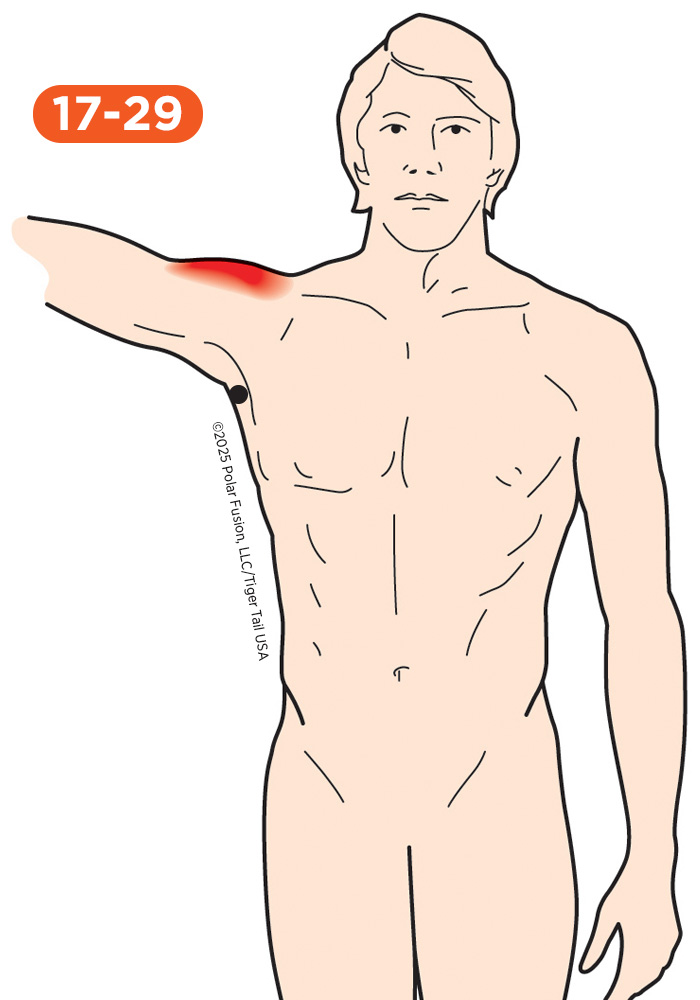
I Feel
Top of Shoulder Pain
That persistent, aching pain right on top of your shoulder is often referred pain originating from tight muscle knots in one of the rotator cuff muscles, the teres major. The discomfort typically focuses around the top of the shoulder joint area and can radiate down the outside of the upper arm, although the source is the shoulder blade. You’ll notice the pain worsens significantly during activities that require forceful reaching or pulling, such as pulling open a heavy door, carrying a heavy suitcase, or reaching overhead for a tool. Since the teres major pulls the arm toward the body, its knotting can easily mimic more serious problems like AC joint arthritis or supraspinatus tendonitis. The tissue deep in the back of the armpit is highly sensitive to pressure, making your shoulder feel heavy and restricted, and limiting your comfortable rotation.

I Feel
Upper Arm Pain
When the muscle that forms the prominent cap of your shoulder, the deltoid, is causing trouble, the pain is usually felt as a focused, persistent ache right over the outer curve of your shoulder. This discomfort often radiates down the side of your upper arm, sometimes stopping halfway down your bicep. This muscle is responsible for lifting your arm in nearly every direction, so you’ll notice the pain gets significantly worse when you try to lift your arm out to the side or hold something away from your body for a long time. It can be super tender if you press on the muscle belly. Issues here are a common contributor to shoulder bursitis or tendonitis, leaving your entire upper arm feeling weak, heavy, and resistant to any lifting motion.

I Feel
Back of Upper Arm Pain
When the pain is concentrated at the top of back of your arm, it is muscle knots from the back shoulder muscle, the posterior portion of the deltoid. You’ll typically feel a deep, throbbing ache that frequently radiates down the back of your upper arm, sometimes making the entire upper limb feel sore and heavy. This muscle’s main job is to pull your arm backward and help with external rotation, so you’ll notice the pain gets significantly worse during activities like reaching behind you or pulling objects toward your body (such as with rowing). It can be super tender if you press on the muscle right where it attaches to the shoulder blade. Issues here are common when the larger front shoulder muscles are overused, leaving this rear section weak, tight, and painfully fatigued.
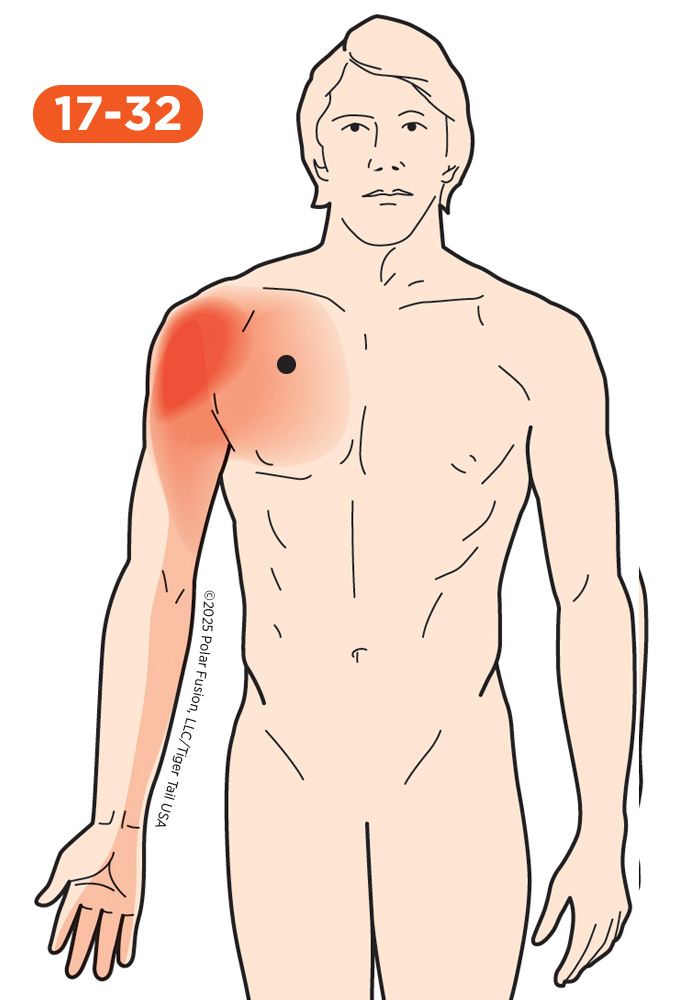
I Feel
Front of Arm Pain
That deep, achy pain in the front of your arm is often referred to as pain coming from muscle knots in the deep chest muscle, the pectoralis minor. The discomfort usually focuses along the inner side of the upper arm and into the forearm, presenting as a deep, dull ache that can sometimes feel like tingling or numbness. You’ll find the pain gets significantly worse when you’re doing activities that round the shoulders, like slouching while driving, carrying a heavy bag across your chest, or sleeping on your side with your arm pulled forward. Because the pectoralis minor can compress nerves and vessels (like in thoracic outlet syndrome), its knotting can easily mimic deeper problems like biceps tendinitis or a cervical nerve pinch. The tissue deep under the collarbone is extremely sensitive to pressure, and it leaves your arm feeling heavy and restricted, limiting your ability to pull your shoulders back comfortably.

